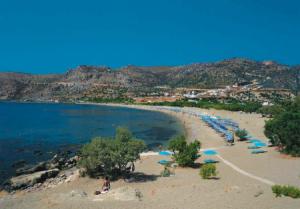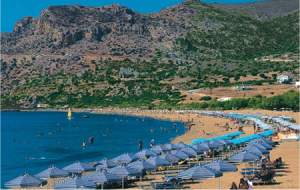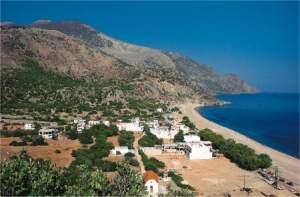|
Paleochora - Sougia
Paleochora
Probably it has been built on the ruins of ancient kalamidi.
In 1282 the Venetians built the historic Kastello Selino after
which the Selino district was named, previously known as "Orina".
 The
township we know as Paleochora was finally established at
the end of 1800. The fortress, which dominates a small peninsula
and commands a lovely view over the Libyan sea, was built
and destroyed again and again by the Venetians, the Turks,
Barbarossa's pirates and later by Cretan rebels and Germans
during the Second World War. At the present Paleochora is
a wonderful large village, with lots of tourists, because
of the great beach and warm sea. There are many hotels, rooms
for rent, taverns, bars, outdoor cinemas, doctor's office
and a nudist beach on the East side. Paleochora is also the
starting point , for a visit by boat to Sougia, Agia
Roumeli, Samaria Gorge, Sfakia
and Gavdos island. Worth visiting is the Venetian castle (Kastello
Selino) which you can admire in the west side. Bear also in
mind that from paleochora there is access to the three gorges
in Southern Crete; Samaria, Aghia Irene (St. Irene) and the
Anidri gorge which is the closest. The
township we know as Paleochora was finally established at
the end of 1800. The fortress, which dominates a small peninsula
and commands a lovely view over the Libyan sea, was built
and destroyed again and again by the Venetians, the Turks,
Barbarossa's pirates and later by Cretan rebels and Germans
during the Second World War. At the present Paleochora is
a wonderful large village, with lots of tourists, because
of the great beach and warm sea. There are many hotels, rooms
for rent, taverns, bars, outdoor cinemas, doctor's office
and a nudist beach on the East side. Paleochora is also the
starting point , for a visit by boat to Sougia, Agia
Roumeli, Samaria Gorge, Sfakia
and Gavdos island. Worth visiting is the Venetian castle (Kastello
Selino) which you can admire in the west side. Bear also in
mind that from paleochora there is access to the three gorges
in Southern Crete; Samaria, Aghia Irene (St. Irene) and the
Anidri gorge which is the closest.  You
can get to Paleochora by suburban bus service (KTEL) from
Chania, by car if you take the road to Kissamos exiting south
at Tavronitis village. (74 km South-West of Chania). You
can get to Paleochora by suburban bus service (KTEL) from
Chania, by car if you take the road to Kissamos exiting south
at Tavronitis village. (74 km South-West of Chania).
Sougia
It is the ancientSiyia, haven of Elyros. The name originates
rather from the word "sis"=pig, namely pigtown.
It appears that there were forests of oak and holly trees,
and there was a systematic rearing of pigs. The bed of the
waterfall of Lakou Zografou divided the still remaining ruins
of the old town into two parts. On the western side there
was a well-defended port which today, with the geological
rise of western Crete has disappeared. The greatest part of
Siyia was on Eastern side where even today we can see reservoirs,
relics of ancient buildings, hot springs and parts of the
city walls.  The
ancient town flourished both in the Roman times and during
the Byzantine period. East of Souyia is the famous gorge of
Tripiti, with a beautiful bay at the exit of the ravine. At
the present, Souyia is a small picturesque harbour, which
offers a great beach, hotels, rooms for rent and taverns.
Worth visiting is the village church, which has 6th century
mosaics of saints and roebucks and the ancient village of
Lisso which has an ancient theatre and baths. You can get
to Sougia by suburban bus service (KTEL) from Chania, or by
car if you take the road to Sougia. (70 km South-West of Chania). The
ancient town flourished both in the Roman times and during
the Byzantine period. East of Souyia is the famous gorge of
Tripiti, with a beautiful bay at the exit of the ravine. At
the present, Souyia is a small picturesque harbour, which
offers a great beach, hotels, rooms for rent and taverns.
Worth visiting is the village church, which has 6th century
mosaics of saints and roebucks and the ancient village of
Lisso which has an ancient theatre and baths. You can get
to Sougia by suburban bus service (KTEL) from Chania, or by
car if you take the road to Sougia. (70 km South-West of Chania).
Lissos
One and a half hour walk or twenty minutes by boat (west of
Souyia) is the ancient seaside town of Lissos, famous for
its curative springs. It's the only town in Western Crete,
together with Irtakina, where they had cut gold coins, on
which the head of Diana and the dolphin with the word "Lission"
were depicted. It is worth visiting the Asklepion temple of
Dorian style, were many statues were discovered, a few in
the natural size of Asklepios, of Eyias (health), of Pluto,
as well as many inscribed pedestals of statues which mention
their being offerings to Asklepios or to Eyia. The floor is
of mosaic with fine multicoloured pebbles, of complex geometric
shapes and pictures of animals. Lissos had a reservoir, a
theatre and hot springs since Roman times. However these have
not yet been excavated. It flourished in the Hellenistic,
but chiefly in the Roman period and in the Byzantine era.
From the Byzantine period we have the ruins of two early Christian
basilici with mosaic floors, where today stand the chapels
of the Virgin Mary and St Kirkos (St Kyriakos).
|
